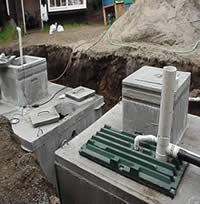Underground Injection Control (UIC) in Region 9: Tribal Wastewater
Under the Safe Drinking Water Act (SDWA), the UIC Program regulates wells that inject fluids beneath the ground surface. The purpose of the program is to ensure that injection activities do not pose a threat to underground sources of drinking water or public health. EPA has direct regulatory responsibility for the UIC program on most tribal lands within Region 9.
- Types of Regulated Systems
- What are the Minimum Federal UIC Requirements for a Wastewater Treatment System?
- Change of Use, Ownership, or Building New
Types of Regulated Systems
Under the UIC Program, subsurface injection practices are classified based on the type of well and type of fluid injectate. The UIC program regulates the shallow injection of non-hazardous fluids in a category called Class V wells. Class V wells are the most common type found on tribal lands and include injection of sewage from large capacity wastewater systems such as wastewater treatment plants or large capacity septic systems. A wastewater system is considered a large capacity system if it receives solely sanitary waste either from multiple dwellings ;or from a non-residential establishment and the system has the capacity to serve 20 or more persons per day.
What are the Minimum Federal UIC Requirements for a Wastewater Treatment System?
 Residential septic tank installation in Santa Cruz County, CaliforniaThe majority of Class V wells, including septic systems and wastewater treatment plant systems, are “authorized by rule” provided they meet these minimum federal requirements:
Residential septic tank installation in Santa Cruz County, CaliforniaThe majority of Class V wells, including septic systems and wastewater treatment plant systems, are “authorized by rule” provided they meet these minimum federal requirements:
- The owner or operator must submit basic inventory information to the permitting authority (EPA)
- The injectate cannot endanger underground sources of drinking water (USDWs)
“Authorized by rule” means that an individual permit is not required. Local, state, or tribal rules governing these wells may be more stringent than the federal regulations. Inventory information to be provided to EPA includes:
- Facility name and location
- Owner’s or operator’s name and address
- Nature and type of injection well
- Operating status
The second minimum federal requirement prohibits injection that allows the movement of fluids containing any contaminates (such as pathogens, nitrogen compounds, solvents, or heavy metals) into a USDW if the presence of that contaminant may cause a violation of any primary drinking water regulation or adversely affect public health.
Any Change of Use or Ownership of an Existing Wastewater System, or Building a New Wastewater System, Requires Notification to EPA
For new or significantly modified wastewater systems, after the tribe has completed final design of the system and prior to any construction related to the proposed wastewater treatment plant system the tribe must meet two requirements. If an owner or operator plans to construct one or more injection wells they are required to 1) not endanger underground sources of drinking water per 40 CFR 144.12 and 2) register at no cost those features, also known as injection wells, with the UIC program per 40 CFR 144.26. To register a system, submit inventory information using this online form, or, if you prefer to mail it to EPA, use Form 7520-16: Inventory of Injection Wells and mail it to the Tribal UIC Wastewater Contact listed above. The EPA UIC online registration is fairly straight forward. If you have any questions or need help, please contact the Tribal UIC Wastewater Contact above.
When the inventory/well registration information is submitted, EPA will evaluate the submittal and determine whether the injection activity can be authorized by rule to operate. EPA may require the tribe to report certain design and operational data to help EPA make this determination. With this data, if required, EPA would evaluate whether the system operation will adversely impact the USDW. Generally, a federal UIC permit will not be required for these systems. Authorization by rule does not imply any endorsement of the engineering plans provided with the inventory information. No construction of the wastewater treatment system should commence prior to submittal, and EPA’s review, of the requested information.
NOTE: Single family residential septic systems that are used solely for sanitary waste and have the capacity to serve fewer than 20 persons a day are excluded from the UIC requirements (40 CFR 144.81(9)).
